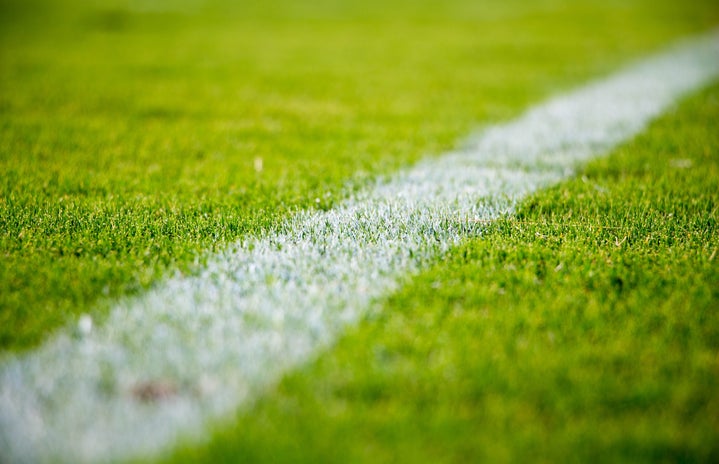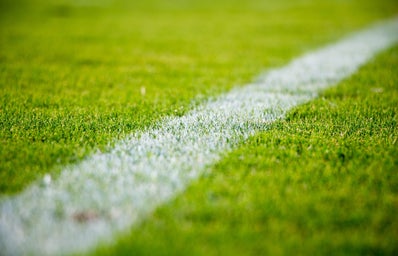It’s sweltering hot. The cute guy that seemed so sweet when you were flirting with him at the tailgate has transformed into a raging beast, screaming “Pass interference!” at the refs until he’s red in the face. The band erupts into the fight song and you have no idea why. The cheerleaders are flipping around and shouting something about “first and 10” and then you could have sworn the other team had the ball but all of a sudden the people around you are screaming “Touchdown!” and jumping up and down and What. Is. Going. On?!
Sound familiar?
College football is fun when you’re painting up with your friends or tailgating with gorgeous guys, but when the actual game starts, it’s easy for non-sports-nut collegiettes to get completely lost between the flags and positions and numbers and just wish they had stayed home instead. But don’t lose hope yet — even if the words “first down” mean absolutely nothing to you right now, HC’s handy football guide will turn you into a pom-pom-waving, screaming football fanatic in no time. Go team!
The Field
Football fields are big. This is not news (why do you think football players’ leg muscles are so huge?). What may actually be news to non-sports-savvy collegiettes is that football fields are different sizes depending on whether it’s a college, NFL or high school field. A college football field is 120 yards long and 53 1/3 feet wide. The two shorter ends of the field where the goalposts are located are called the end zones, which are 10 yards deep, while the longer edges of the field, where the players sit while they’re not playing, are called the sidelines. There are lines drawn every five yards across the field leading up to the 50-yard line in the middle, with the lines at each end zone starting at 0 and going up toward the middle.
The Clock
Football is played in four 15-minute quarters. But wait — how the heck do games last for so long, then? Well, the clock stops between each play for the teams to reset their positions, and there is a 20-minute halftime between the second and third quarters, so games get stretched out a little longer than an hour (try three or more). Each team also is allowed to have three 30-second timeouts per half so that the coach can talk to his players or challenge a call made by a referee, although the teams are not required to use all of their timeouts in a game. The clock counts down, so at the start of each quarter the clock will read: 15:00.
The Players
Each team is allowed to have 11 players on the field at a time, although most college teams have many more players on the actual roster — it’s not uncommon for a team to have more than 100! One reason college teams have so many players is because they have three different groups of players (and a lot of backups) that go on the field at different times: offensive players, defensive players and special teams. The offense is on the field when their team has the ball. They’re the guys that try to run the ball down the field and score points. The defense, which is on the field when the opposing team has the ball, tries to stop the opposing team’s offense from scoring points. Special teams are players who are put out for specific tasks such as kicking field goals or punting the ball to the other side of the field if the offense is stopped (they also have the coolest name, probably to make up for the fact that they don’t get to be on the field as often).
There are a ton of different football player positions, but the most important one to remember is the quarterback. A play starts with the offense and the defense setting up in lines facing each other. One of the offensive players hands the ball backwards between his legs to the quarterback (this move is called the snap), who then decides whether he is going to hand the ball to someone else, throw the ball to someone else or run with it himself. This is why the quarterback is so important: he (or she!) is the leader of the group on the field who takes direction from the coach and tells the other players what to do. (Also, is it just us or is the quarterback always the hottest guy on the team? Confidence is sexy.)
Helpful hint: There is an invisible line (use your imagination here) between the offense and defense called the line of scrimmage that no player is allowed to cross before the snap happens.
Related: This Incoming College Student Wants To Be The First Female NFL Player
The Goal
The goal of football is to score points (obviously?), either by making a touchdown or kicking a field goal. A touchdown, which is worth six points, happens when one team’s offense takes the ball all the way into the other team’s end zone, either by running the ball or passing it, without getting stopped by a defensive player on the other team.
Once a team scores a touchdown, they have two options. They can try for a field goal, where they kick the ball between the two goal posts and get one extra point, or they can try for a two-point conversion, where the team sets up at the two-yard line and attempts to score another touchdown for an extra two points in addition to the six points they got from the first touchdown. Teams typically choose the field goal because it’s easier, unless they’re running out of time and really need two extra points instead of just one.
A team can also kick a field goal from any point on the field without scoring a touchdown for three points. Teams usually go this route if they are on their fourth down and don’t think they will be able to make a first down.
Downs
We didn’t confuse you too badly with that last sentence, did we? The “down” lingo is typically where collegiettes who weren’t religiously raised on football Saturdays get confused, but it’s actually a simple concept. A down is basically a play. Each offensive line has four chances to move the ball ten yards down the field, whether by passing or running the ball (carrying it with them), without being stopped by the other team (tackling the player with the ball). When one team gets the ball down the field at least ten yards from where they started (the line of scrimmage) without being stopped by the other team’s defense, it’s called a first down. If the offense gets a first down, they keep trying to get the ball down the field until they either score a goal or are stopped by the other team before they get another first down (make it 10 more yards).
If the player with the ball is tackled by a defensive player, they start from where they were tackled and try to get the ball the rest of the ten yards. After four unsuccessful tries, the ball goes to the other team. The other team can also catch the ball in the middle of a pass, called an interception, in which case the ball would immediately switch hands to the other team. Easy enough, right?
So when you hear the cheerleaders shouting: “first and 10, do it again,” they mean that the team has made it down the field 10 yards and has another 10 yards to go before they get another first down. Same goes for second and five (second try and they have five yards to go before a first down), third and two (third try, two yards to go), and so on. Still following? Good.
Common Fouls
Fouls are typically what causes those seemingly nice college guys to turn into snarling, furious animals bellowing at the referees. Despite what the enormous muscled guys literally slamming each other into the ground may lead you to believe, there are actually some things you’re not allowed to do in college football for fear of injuring a player or giving your team an unfair advantage. The referees (the people wearing black-and-white striped shirts) signify that a foul has occurred by throwing a yellow flag on the field where the foul occurred. If the announcer says that “there is a flag on the play,” he means that a referee has called a foul. Here’s a quick list of some common fouls that could happen during a game so you can impress that guy next to you by screaming at the ref before he can.
The Foul: Encroachment
What it is: Remember how you can’t cross the line of scrimmage before the snap? If a defensive player does it and touches an offensive player, it’s a penalty.
What happens: The offense gets to move forward five yards; therefore, they will have five less yards to cover to get a first down.
The Foul: False start
What it is: An offensive player makes a movement before the snap.
What happens: The offense has to move backwards five yards.
The Foul: Holding
What it is: An offensive player holds a defensive player so that the defensive player can’t tackle the player with the ball.
What happens: 10-yard penalty.
The Foul: Offside
What it is: A player (or any part of him, really) is beyond the line of scrimmage before the play starts.
What happens: 5-yard penalty.
The Foul: Pass interference
What it is: Here’s where it gets confusing. Yes, defensive players are supposed to prevent offensive players from getting the ball, but they can’t make contact with the receiver (the player who a pass is intended for) before the ball gets to him. That’s called pass interference, and it’s a foul. The defensive player can, however, touch the receiver after he touches the ball. The defensive player can also intercept the ball without touching the receiver.
What happens: 15-yard penalty and an automatic first down for the offense.
The Foul: Personal foul
What it is: Any action that appears to be done in order to intentionally harm another player (you can’t just punch each other, guys).
What happens: 15-yard penalty. If the foul is particularly nasty, a player can be ejected from the game.
Congratulations on officially becoming a collegiette football expert (or at least more knowledgeable about football, anyway)! Now go paint up or don a jersey in your school’s colors, jump up and down in the stands and school your guy friends on the rules of America’s favorite college sport (“It’s ‘offside,’ not ‘offsides,’ Brad.”). Who says girls don’t get sports?

